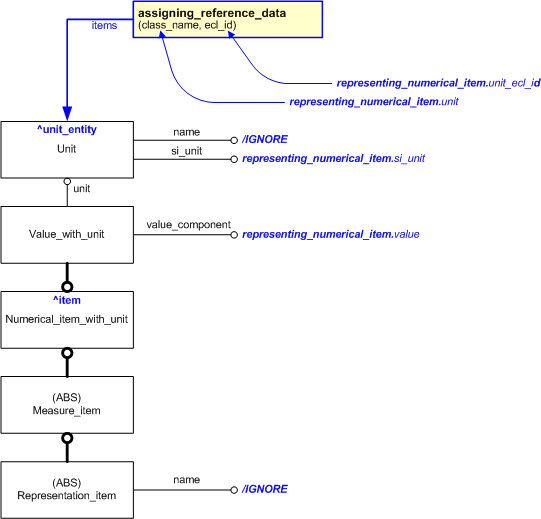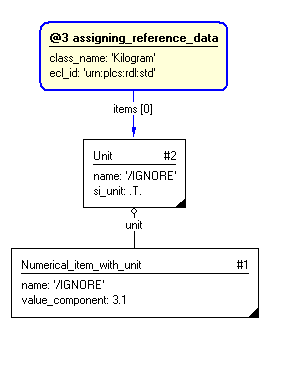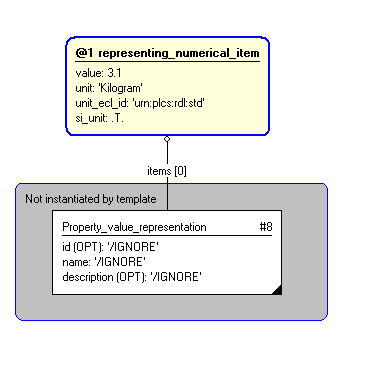| Template:— representing_numerical_item (rep_num_item) |
Date: 2008/03/10 08:13:07
Revision: 1.22
|
This section specifies the template representing_numerical_item.
NOTE
An explanation of a template and the associated instantiation path is
provided in the
Template overview
section.
This template describes how to represent a numerical item with unit. A numerical item is referenced from a (subtype of)
Representation, as is the case for properties.
EXAMPLE
The value and unit of a product property, e.g. "3.1 kg" for a weight property.
The EXPRESS-G diagram in
Figure
1
shows the templates and EXPRESS entities that are required
to represent the template
"representing_numerical_item".
The text highlighted in blue shows the template parameters.
Figure 1 — An EXPRESS-G representation of the Information model for representing_numerical_item
The graphic for the template to be used in other EXPRESS-G diagrams
is shown in Figure
2
below.
Figure 2 —
The graphical representation of representing_numerical_item template
The following input parameters are defined for this template:
The value of the property. The datatype is always 'any_number_value'
and should not be registered together with the value, i.e. enter the
value as a number, without datatype.
The class name of the unit in which the value is expressed, defined in external reference data.
The following classes and their sub-classes can be used:
The identifier of the
External_class_library
storing the definition of the class referenced by the parameter @unit.
Value should be set to true if the unit is a SI base unit defined by ISO, i.e.
kilogram (kg) for Mass,
second (s) for Time,
metre (m) for Displacement,
ampere (A) for Electrical current,
kelvin (K) for Temperature,
mole (mol) for Amount of substance, and
candela (cd) for Luminous intensity. If this is not the case it should be set to false.
Note that the representation of true and false depends on exchange format. In Part 21 (a STEP file) true is
represented by the string ".T.", and false by ".F.", while in Part 28 (XML) they are represented by text
strings "true"
and "false".
The following reference parameters are defined for this template:
%^target = $representing_numerical_item.item%
Allow the
Unit
entity instantiated in this path to be referenced when this template is used.
Note: The
Unit
entity can be referenced in a template path by:
%^target = $representing_numerical_item.unit_entity%
where
target
is the parameter to which the
Unit
is bound.
The following parameter combinations specify a uniqueness constraint:
Unique constraint: Unique Unit
There shall be at most one instance of the
entity
(
Unit)
within the data set uniquely identified
by a combination of the following parameters on this
template (representing_numerical_item) namely:
unit,
unit_ecl_id.
The
instance is
referenced by the following template parameter:
unit_entity.
The instantiation path shown below specifies the entities that are to be
instantiated by the template.
The following entities are instantiated with attributes as specified:
The instance diagram in Figure
3
shows an example of the EXPRESS entities and templates that are instantiated by the template:
/representing_numerical_item(value='any_number_value(3.1)', si_unit='T', unit='Kilogram', unit_ecl_id='urn:plcs:rdl:std')/
(an illustration of the consolidated representing_numerical_item template is shown in
Figure
4 below.)
Figure 3 — Entities instantiated by representing_numerical_item template
The instance diagram in
Figure
4
shows the graphic symbol for the template that is to be
used in other instance diagrams. The example template is:
/representing_numerical_item(value='any_number_value(3.1)', si_unit='T', unit='Kilogram', unit_ecl_id='urn:plcs:rdl:std')/
Figure 4 — Instantiation of template
Characterizations
No common characterizations of the template
representing_numerical_item
have been identified. However, the ISO 10303-239 EXPRESS model
may enable other assignments to the entities instantiated by the template.




